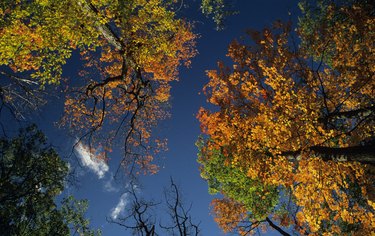
Sugar maples (Acer saccharum) are prized by home gardeners for their dense canopies and their sweet sap, which is used to make maple syrup. Hardy in U.S. Department of Agriculture plant hardiness zones 3 through 8, sugar maples are generally easy to care for, but mushrooms growing on the bark indicate infection by decay fungi, which can seriously weaken the tree.
Artist's Conk
Video of the Day
Artist's conk (Ganoderma applanatum) infects the living and dead tissue of sugar maple trees and produces bracket-like, woody-textured conks that can live for five to 10 years and grow to more than 3 feet wide. Each year, the fungus produces a new spore-producing layer over the previous one. The white surface of the new layer and the new margin of growth are visible on top of the conk, because the older parts are typically dark brown to gray. If you scratch the white layer, it turns brown immediately. By the time you see these mushrooms on your sugar maple, extensive decay has already occurred and the tree should be removed to prevent injury from falling limbs.
Video of the Day
Northern Tooth Fungus
Clusters of large, white, fleshy, shelf-like mushrooms that are aligned one on top of another are caused by the Northern tooth fungus (Climacodon septentrionalis). The entire structure of this fungus's fruiting bodies can extend 1 foot wide and up to 30 inches long. This fungus infects your sugar maple through wounds and cracks, causing a white spongy heart rot in the wood. By the time the mushrooms appear on the tree, the decay is usually extensive and the tree is vulnerable to breakage, so it should be removed.
Sulfur Fungus
The fungus Laetiporus sulfureus produces clusters of shelf-like, bright sulfur to orange or salmon-colored mushrooms on infected sugar maples in the summer and early fall. These grow to between 8 and 12 inches wide and appear singly or in clusters every year, and become brittle and white as they age. However, the mushrooms don't appear until several years after infection and indicate serious internal damage of your tree. Sulfur fungus causes decay in the tree's roots, butts, and stems, and reduces wood strength. Trees with these mushrooms should be removed immediately.
Armillaria Root Rot
Armillaria root rot (Armillaria mellea) is sometimes referred to as shoestring root rot, and is one of the most destructive fungal diseases affecting the roots and butts of most tree species, including sugar maples. The fungus establishes itself in the root systems of stressed trees, and if severe stresses such as drought occur after infection, tree death can result. Armillaria root rot spreads through roots using fungal structures called rhizomorphs, which are black, stringy structures. Armillaria root rot produces a honey-colored mushroom on the roots of the tree. The cap of the mushroom is 1 to 4 inches in diameter and yellowish brown in color. Decay caused by this fungus can be slowed by removing the soil from around the base of your sugar maple so the infected roots can dry.
- Cornell Sugar Maple Research and Extension Program: Some Common Decay Fungi
- Cornell Sugar Maple Research and Extension Program: Root and Butt Rots
- Pennsylvania State University Extension: Maple Diseases
- University of Florida Extension: Acer Saccharum
- University of California Extension: Wood Decay Fungi in Landscape Trees
- University of Wisconsin Plant Teaching Collection: Tom Volk’s Fungus of the Month for February 2001